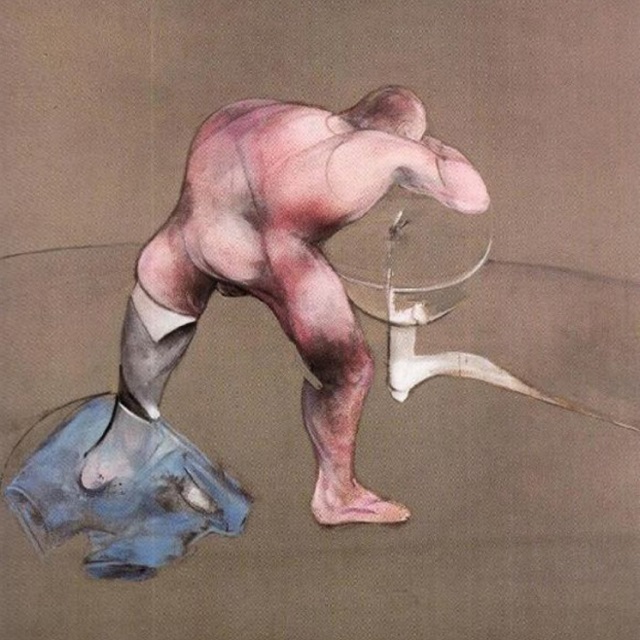
Between Bacon and Mwesiga there’s often a striking connection in studio deftness and philosophy
Kampala, Uganda | DOMINIC MUWANGUZI | Francis Bacon was an Irish-born artist whose obsession with raw and unsettling imagery earned him global recognition as one of the most sought after artists of his generation.
His abstract human figure portraits were expressive of his inner persona and daily engagement with his peers. Through the introspective paintings the artist seemed to be routinely fleeing from the shackles of his own life.
Bacon grew up in a war tormented background which exposed him to violence as a child. When he grew up, he acquired a strong affinity for alcohol and sex which possibly was an escape-route to the realities of his unfortunate childhood background.
The extremely brutal imagery – like some critics have described it- therefore became emblematic to his artistry providing more than expression of the inner- self, but a metaphor for the human condition.
Previous works by artist Ian Mwesiga reveal a striking connection between him and Bacon. Mwesiga’s self- portraitures which appear in a sketchy form with impulsive, rough and amateurish like drawings, capture the artist’s inner- self.
“I close my eyes and draw my face. Whatever I am able to capture is what I go with,” the artist told me in an interview in 2014. Like his model, Bacon, Mwesiga’s paintings were created in a format of a diptych or triptych not only as a gesture to create sequence in the artwork, but to demonstrate the different elements of the same subject. Such technique and display, suggest the nature of the subject matter the artist are working with.
Introspection, a theme that pervaded the two artists work is a delicate and intricate subject that requires constant examination to elicit credible and accurate results. The process also demands extreme concentration. Therefore, a multiple representation of the subject suggests the differences in their emotional experience which ultimately lead to different interpretations by the audience.
Mwesiga as subject in the paintings assumed different postures which suggested his different emotional -psychological experiences within the context of “capturing the self”. One painting illustrates his face downcast as if shy from the viewer’s gaze, and therefore can be interpreted as an allusion to the artist’s moments of anxiety perpetuated by different experiences in everyday life.
Mwesiga’s recent paintings have also continued to be works of art inspired by the iconic figure of the 20th Century. Though they are far from the theme of melancholy which denoted the artist’s preoccupation of finding himself back then, these paintings imbue a certain delicate similarity in studio deftness and execution. Man Standing by the Pool, 2020 is identical to Bacon’s Man at a Washbasin, 1989–90 and Male nude before Mirror, 1990. The connection between the three paintings is observed in the presentation of the solitary human figure in the composition, the relationship between the subject and his immediate surrounding, and the technique of mystery and suspense instilled in the paintings by the contemporary imagery.
 Mwesiga’s Man standing by the Pool has a solitary figure standing erect next to the pool. However, unlike in the two paintings of Bacon were the subject faces directly the mirror or Washbasin, in Mwesiga’s figurative painting, the shirtless male figure dressed in a white vest and dark blue shorts, stands by the pool as if to suggest he’s simply posing there for the hidden camera. The act of standing by the pool could have more connotations than imagined as metaphorically suggested by the artist who often wants to defy logic with his compositions. In all the three paintings, the subjects are a visual representation of the artist or those in their immediate surroundings.
Mwesiga’s Man standing by the Pool has a solitary figure standing erect next to the pool. However, unlike in the two paintings of Bacon were the subject faces directly the mirror or Washbasin, in Mwesiga’s figurative painting, the shirtless male figure dressed in a white vest and dark blue shorts, stands by the pool as if to suggest he’s simply posing there for the hidden camera. The act of standing by the pool could have more connotations than imagined as metaphorically suggested by the artist who often wants to defy logic with his compositions. In all the three paintings, the subjects are a visual representation of the artist or those in their immediate surroundings.
The ritual of washing in the washbasin or standing in front of the mirror is a self- reflective activity which figuratively exposes the emotional and psychological well-being of the individual. Bacon could have created the paintings to express his intense moment of anxiety brought about by his sex and alcohol addictions. Conversely, Mwesiga’s Man standing by pool may be about his personal relationship with swimming, or the idea of dealing with the self figuratively represented by the shadow and reflection created by the water in the pool. Both elements- shadow and reflection- evoke how we perceive ourselves or want to be perceived by those in our surroundings. Hence, the ritual of looking in the mirror.
Mwesiga’s art has in recent times been described as an archive of historical and intimate photography which is situated in the contemporary environment within which he lives in. He relies on past personal experiences and old photographs to convey a unique message of his subjects’ – often those in his immediate surroundings- social and psychological identity. This is more like Bacon’s isolated abstracted figures wrapped in geometrical structures which challenge the common perception that art is not simply about aesthetics. To both artists, art is certainly an expression of what lies beneath our everyday existence.
****
 The Independent Uganda: You get the Truth we Pay the Price
The Independent Uganda: You get the Truth we Pay the Price


